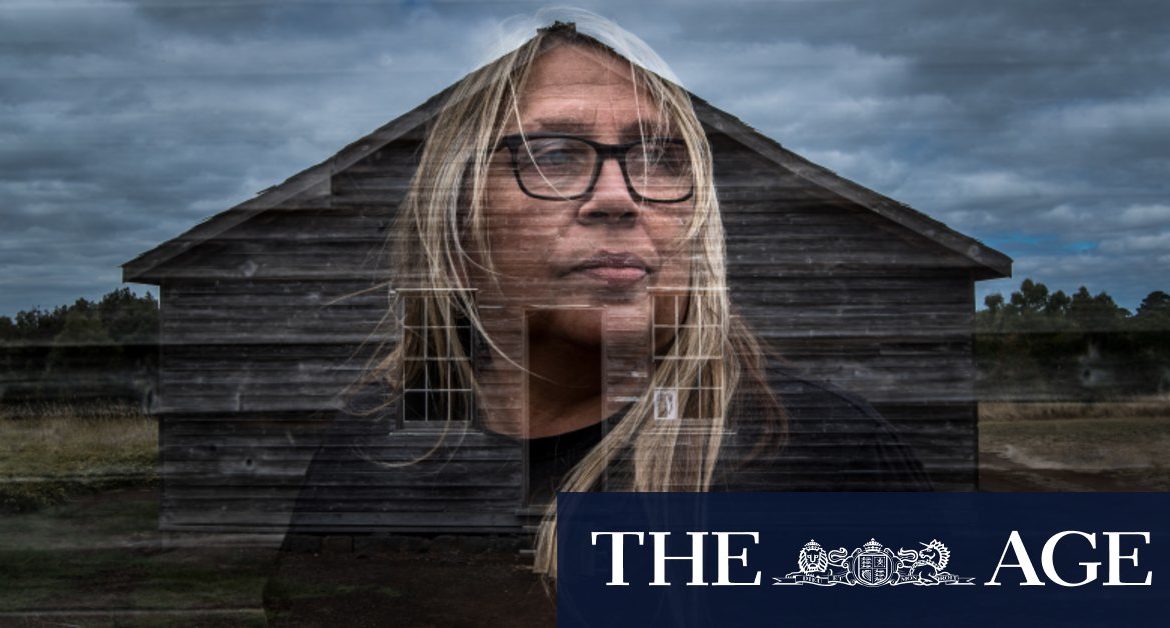Behind the bluestone ruins of the Lake Condah Mission, at the edge of ancient Budj Bim stone country, inside a charming paddock dotted with cattle and a hayshed, rests a small parcel of Gunditjmara ground Aunty Donna Wright is forbidden to tread.
It is sacred land, she was told by her mother and grandmother, as they themselves were told: the spiritual resting place of ancestors murdered some 170 years ago for refusing to die.
Murderers’ Flat, as it came to be known, is no place for her trampling feet.
Aunty Donna Wright in an old dormitory at the Lake Condah Mission.Credit:Justin McManus
Oral tradition – for that is the only kind of story to survive this killing – counts anywhere between half a dozen and 300 people dead. It may have been combat – and the “fighting Gunditjmara” could rise against the settlers and their guns – although there is no story of white men’s death or injury here.
Depending on the account, the families by Darlots Creek, deprived of hunting grounds by expanding white occupation, may have been lured half-starved from their small stone huts and poisoned with arsenic-laced flour.
According to historian Ian D. Clark, Murderers’ Flat was the last of 28 documented massacres from two decades of frontier wars in the Dhauwurd-Wurrung language area of south-west Victoria, a region loosely stretching from Warrnambool to the Glenelg River in the west and north towards the Grampians. Conflict began in 1833 or ’34 at the Convincing Ground on Portland Bay, where whalers almost wiped out the entire Kilcarrer Gunditj clan in a dispute over a beached carcass.
Estimates of the dead range from a couple of dozen to a couple of hundred.
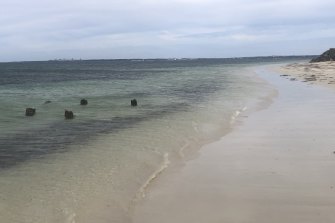
Old pylons that once supported a slipway for whalers’ boats at The Convincing Ground, the site of Victoria’s first massacre of Aboriginal people, near Portland. Credit:Tony Wright
“There is a brutal history down here in the south-west – and that needs to be told,” says Aunty Donna, a member of the First Peoples’ Assembly of Victoria – the state’s democratically-elected Aboriginal body tasked with setting the course to treaty.
“It was domestic terrorism the way our mob were treated.
“But there’s this gap in history. This gap in knowledge.”
Last week, the assembly and the state government announced the Yoo-rrook Justice Commission to begin filling those gaps with the purpose, platform and powers of a royal commission.
Beginning in months, it will explore the trauma of colonisation and its intergenerational expression. It will also hear of survival and success. Hearings will end in 2024, following an interim report delivered in the middle of next year.
The government and opposition have both committed to supporting the recommendations which, it is hoped, will be fed into government policy and future treaties with First Nations groups.
Nira illim bulluk man of the Taungurung Nation and assembly co-chair Marcus Stewart explains Yoo-rrook as a royal commission into the “true history” of Victoria.
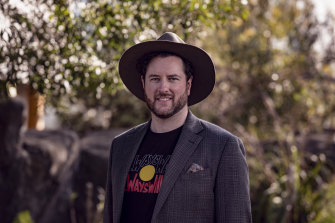
Marcus Stewart is a Nira illim bulluk man and co-chair of the First Peoples’ Assembly of Victoria.
While it will be confronting, elders say, it will build understanding between Indigenous and non-Indigenous Australians still missing after more than 230 years of Australian colonisation, conflict and conversation.
“You get sick of going back to grade one with people,” says Gunditjmara elder Daryl Rose, who disappears into the bush every January 26 in part to avoid the obligatory question: What do you think?
“If we can get more people understanding this stuff, the basics and the history, we can go further up the track and start expanding on things and actually looking for solutions.”

Gunditjmara elder Uncle Daryl Rose in front of the killing field known as Murderers’ Flat.Credit:Justin McManus
The surviving families and descendants of the dead at Murderers’ Flat were most likely among the first Gunditjmara to move into the Lake Condah Mission when it was opened in 1867 by the Church of England.
They hauled stone for the church, which was built in 1883, and recited prayers and hymns in English, for traditional language was discouraged. They picked fruit from the mission orchards and women were taught sewing and housewifery. Transgressions were punished by withholding rations.
Uncle Daryl says those who resisted the mission were viewed by their white contemporaries as “bad people” – the “real blacks”, sure to die off quickly and easily.
Loading
Stripped of their land and culture, enclosed where “the only right was the right to become whiter”, the people of the mission were, in his view, the first generation of stolen Gunditjmara.
From 1886, the first year of the Half-Caste Act, any Gunditjmara at the mission with European blood was banished to assimilate into white populations. Those remaining, considered “full blood”, were provided spiritual and physical nurture until their race faded into history.
Despite the indignities suffered at the hands of a nation that had rejected their right to exist, more than a dozen Gunditjmara born in and around the time of the Half-Caste Act answered the call when Australia entered the Great War in 1914.
On their return they watched their ancestral country carved up as part of the soldier settlement scheme and handed to the diggers they fought beside.
The rich volcanic soil – bought, sold or passed to children – provided for intergenerational wealth. No one from the contingent of fighting Gunditjmara received a thing.
Yet over time, something special grew within the Gunditjmara at the Lake Condah Mission.
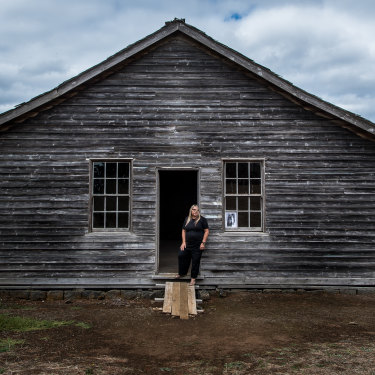
Gunditjmara elder Aunty Donna Wright outside the old dormitory at Lake Condah Mission. Aunty Donna’s mother Eunice Wright and her sister Gloria were stolen while walking home from school to the mission in 1954.Credit:Justin McManus
By the time it closed in 1919, it was no longer an institution in the instruction of whiteness but a place of family and refuge – a living monument to survival.
Families stayed on, Uncle Daryl says. They played sports carnivals and the relatives from towns and the wider region gathered and yarned at the church on Sundays. In 1957, authorities blew the church up with dynamite, ostensibly because it was damaged beyond reasonable repair.
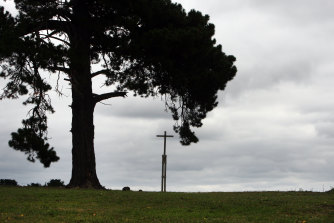
A cross stands on the site of the Lake Condah Mission’s church, destroyed in 1957. Credit:Leanne Pickett
“First it was the dispersal from their traditional country onto a mission, then it was dispersal again,” Uncle Daryl says. “But this is where our families continued.” The Gunditjmara had reclaimed the site’s meaning.
By 1987 they had also reclaimed ownership and today that land is the home of the Gunditj Mirring Traditional Owners Corporation. The striking construction is modelled on the stone huts where their ancestors lived in what we now call the Budj Bim Cultural Landscape.
There, just kilometres behind the tree line, people built intricate weirs and traps at least 6600 years ago for perennial harvesting of eels and fish in a feat of such ancient ingenuity it was declared a UNESCO World Heritage Site in 2019.

Budj Bim rangers Aaron Morgan and Leigh Boyer stand by replica stone houses in the UNESCO World Heritage-listed Budj Bim cultural landscape.Credit:Justin McManus
The stories and survival of the Gunditjmara on this small stretch of country are illustrative when considering the scope and purpose of the Yoo-rrook commission.
Such reckoning with the past – the massacres, missions, discrimination, stolen generations and wonders – will lay the necessary foundation for a reconciled future, elders say.
“It is going to actually give our fellow Victorians the opportunity to get an understanding of why treaty is so important – why it will redefine our relationships, for all of us, and why it will be better for all of us,” Marcus Stewart says.
Put simply, Yoo-rrook is the ‘why’, treaty is the ‘what’, he says.
The job of the 31-person assembly, comprised of elected community members and traditional owners’ representatives, is to set down the framework from which treaty will emerge. The detail – the binding accords to address Aboriginal grievances and disadvantage – will come from First Nations communities.
Stewart hopes to see treaty making in Victoria “within the next couple years”.
In June last year, the Assembly voted to progress a hybrid model of treaty.
Co-chair Geraldine Atkinson, a Bangerang woman from the state’s north, says this will involve an overarching treaty with First Nations Victorians – a lens, perhaps, through which all policy decisions are viewed – that will be complemented by individual treaties with traditional owners groups specific to their own journeys to self-determination.
Important to the assembly, Aunty Geraldine says, is that all Victorians win. “This isn’t about coming for people’s backyards,” she says.
All options are on the table. But agreements and reforms to reduce the over-representation of Aboriginal people in the justice and child protection systems are obvious.
“There have been pilots to work with families to address those high [child] removal rates, but we need to do more than that,” Aunty Geraldine says.

Aunty Geraldine Atkinson of the First Peoples’ Assembly with acting Premier James Merlino and (right) Marcus Stewart at the launch of the Yoo-rrook Justice Commission in Coranderrk, Victoria, on Tuesday.Credit:Simon Schluter
“We need to do it with more than just deep pockets and we need to ensure that what happens is statewide, not just in a few communities.”
Stewart says treaty “has no implications, only opportunities”. He sees more and stronger joint ventures and economic development creating jobs for all Victorians.
On a human-to-human level, he longs for a day when Indigenous and non-Indigenous Victorians may converse in a native language as people do in New Zealand, where Maori language is taught in schools, spoken on television and sung in the national anthem.
Politically, treaty negotiations could involve exploring means of self-government. Options at the Victorian parliament level include designated seats – another lesson from New Zealand – or a “voice” like that proposed at a federal level by the Uluru Statement from the Heart.
“We’ve currently got a parliament that’s so comfortable in criticising us or politically wedging us … yet the deficits are growing,” Stewart says.
“So let’s look at some pragmatic solutions and how we work together to deliver better outcomes. That’s what treaty can deliver … I think [self-government] is going to be a conversation that evolves with our communities over time.”
International examples are providing inspiration. In a trip to Arizona in the United States, the co-chairs found treaties between governments and First Nations tribes provided for Indigenous court systems, police forces, prisons on tribal lands and the ability to create and enforce laws.
“There’s that example out there, but that’s something we have to work through and just see how practical that would be within the state of Victoria,” Stewart says.
“Is that something we want? We haven’t had that conversation yet.”
In the Canadian province of British Columbia, multiple “modern treaties” have been signed with Indigenous tribes. One of them, the Nisga’a Treaty, provides First Nations people with principal authority over tribal lands, a “significant measure” of self-government and rights to create a range of laws, so long as they are compatible with Canada’s constitution.
Small practical accomplishments include improvements to roads. More complicated matters include economic development funds and a tax rebate shared among village governments.
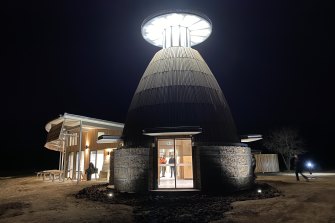
The new Keeping Place at the old Lake Condah Mission.Credit:Gunditj Mirring Traditional Owners Aboriginal Corporation
Back home, the Victorian First Peoples’ Assembly is calling for submissions about creating a self-determination fund, which it describes as a financial resource to empower First Nations people in “treaty-making processes that are nation building and will build capacity, wealth and prosperity”.
One treaty and truth-telling matter which is front-of-mind for Aunty Geraldine this week is the school curriculum.
She has grandchildren and extended Atkinson family attending Greater Shepparton Secondary School, which has been the subject of a leaked Department of Education and Training report alleging “systemic racism” among its staff.
“What we have to do is make sure that we have Aboriginal staff, Aboriginal culture and Aboriginal languages taught in these schools so that we can make them acceptable to all our children,” she says.
Loading
“I’ve spoken to lots of people who have said ‘Why weren’t we taught these things in school? We weren’t taught any Aboriginal history, any Aboriginal culture, any of the things that occurred during colonisation’ – and people want to know.
“That really gives me heart that during this truth-telling process people will be able to listen and hear.”
Out on Gunditjmara country, Uncle Daryl is not underestimating the challenge ahead.
All it takes is a wedge, a headline or a scaremongering opinion piece from a commentator for sectors of the non-Indigenous community to retreat to the status quo, he says.
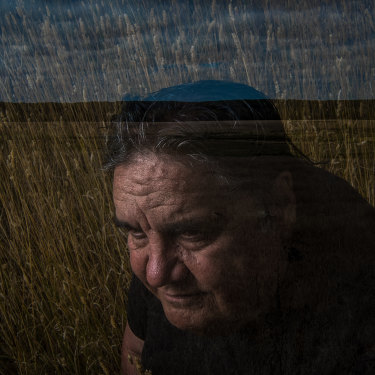
Uncle Daryl Rose at Murderers’ Flat next to the Lake Condah Mission.Credit:Justin McManus
“And the mob also have some exploring to do,” he says. “We’ve got 58 clans potentially in our area. Do we break [discussions] down even further? Who knows?
“It’s going to be an interesting road for our Koori community to get its head around this stuff … The government also has to get its head around it on behalf of all their other constituents, too.”

